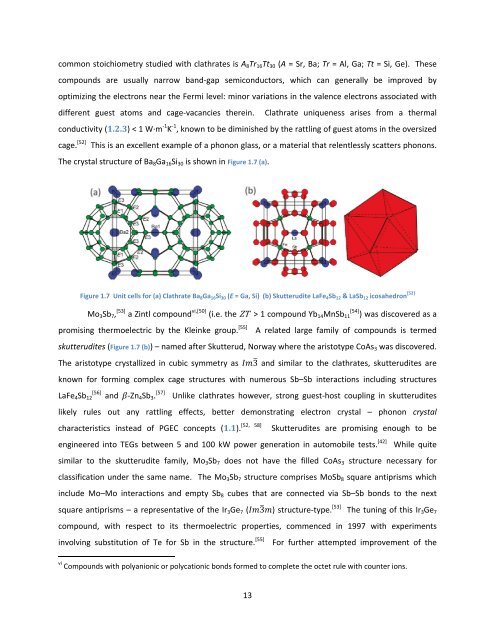Exploration and Optimization of Tellurium‐Based Thermoelectrics
Exploration and Optimization of Tellurium‐Based Thermoelectrics
Exploration and Optimization of Tellurium‐Based Thermoelectrics
Create successful ePaper yourself
Turn your PDF publications into a flip-book with our unique Google optimized e-Paper software.
common stoichiometry studied with clathrates is A8Tr16Tt30 (A = Sr, Ba; Tr = Al, Ga; Tt = Si, Ge). These<br />
compounds are usually narrow b<strong>and</strong>‐gap semiconductors, which can generally be improved by<br />
optimizing the electrons near the Fermi level: minor variations in the valence electrons associated with<br />
different guest atoms <strong>and</strong> cage‐vacancies therein. Clathrate uniqueness arises from a thermal<br />
conductivity (1.2.3) < 1 W∙m ‐1 K ‐1 , known to be diminished by the rattling <strong>of</strong> guest atoms in the oversized<br />
cage. [52] This is an excellent example <strong>of</strong> a phonon glass, or a material that relentlessly scatters phonons.<br />
The crystal structure <strong>of</strong> Ba8Ga16Si30 is shown in Figure 1.7 (a).<br />
Figure 1.7 Unit cells for (a) Clathrate Ba 8Ga 16Si 30 (E = Ga, Si) (b) Skutterudite LaFe 4Sb 12 & LaSb 12 icosahedron [52]<br />
Mo3Sb7, [53] a Zintl compound vi,[50] (i.e. the ZT > 1 compound Yb14MnSb11 [54] ) was discovered as a<br />
promising thermoelectric by the Kleinke group. [55] A related large family <strong>of</strong> compounds is termed<br />
skutterudites (Figure 1.7 (b)) – named after Skutterud, Norway where the aristotype CoAs3 was discovered.<br />
The aristotype crystallized in cubic symmetry as 3 <strong>and</strong> similar to the clathrates, skutterudites are<br />
known for forming complex cage structures with numerous Sb–Sb interactions including structures<br />
LaFe4Sb12 [56] <strong>and</strong> ‐Zn4Sb3. [57] Unlike clathrates however, strong guest‐host coupling in skutterudites<br />
likely rules out any rattling effects, better demonstrating electron crystal – phonon crystal<br />
characteristics instead <strong>of</strong> PGEC concepts (1.1). [52, 58] Skutterudites are promising enough to be<br />
engineered into TEGs between 5 <strong>and</strong> 100 kW power generation in automobile tests. [42] While quite<br />
similar to the skutterudite family, Mo3Sb7 does not have the filled CoAs3 structure necessary for<br />
classification under the same name. The Mo3Sb7 structure comprises MoSb8 square antiprisms which<br />
include Mo–Mo interactions <strong>and</strong> empty Sb8 cubes that are connected via Sb–Sb bonds to the next<br />
square antiprisms – a representative <strong>of</strong> the Ir3Ge7 (3) structure‐type. [53] The tuning <strong>of</strong> this Ir3Ge7<br />
compound, with respect to its thermoelectric properties, commenced in 1997 with experiments<br />
involving substitution <strong>of</strong> Te for Sb in the structure. [55] For further attempted improvement <strong>of</strong> the<br />
vi Compounds with polyanionic or polycationic bonds formed to complete the octet rule with counter ions.<br />
13
















